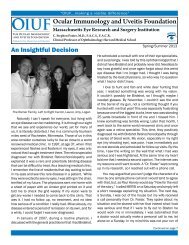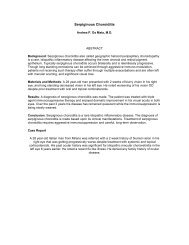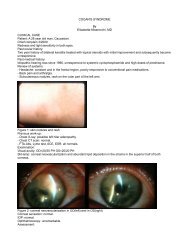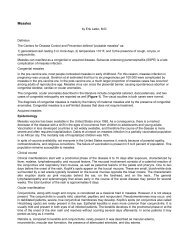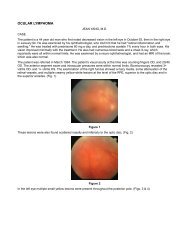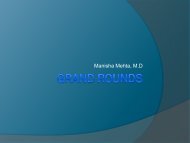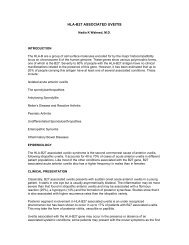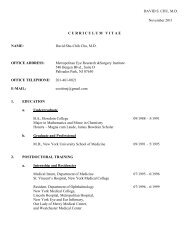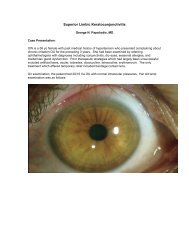COnFerenCe SyllabUS - Ocular Immunology and Uveitis Foundation
COnFerenCe SyllabUS - Ocular Immunology and Uveitis Foundation
COnFerenCe SyllabUS - Ocular Immunology and Uveitis Foundation
Create successful ePaper yourself
Turn your PDF publications into a flip-book with our unique Google optimized e-Paper software.
The <strong>Ocular</strong> <strong>Immunology</strong><strong>and</strong> <strong>Uveitis</strong> <strong>Foundation</strong>’sSymposium onChildhood <strong>Uveitis</strong>Conference SyllabusThe Cambridge MarriottCambridge MassachusettsSeptember 29, 20128:00am - 12:40pm
The <strong>Ocular</strong> <strong>Immunology</strong><strong>and</strong> <strong>Uveitis</strong> <strong>Foundation</strong>’sSymposium on Childhood <strong>Uveitis</strong>I. AgendaThe Cambridge MarriottCambridge MassachusettsSeptember 29, 20128:00am - 12:40pmTABLE OF CONTENTSII.BiographiesIII. Childhood <strong>Uveitis</strong>IV. JIA-Associated <strong>Uveitis</strong>V. Treatment OptionsVI. CME Instructions
Educational ObjectivesIn response to the challenges <strong>and</strong> opportunities described above, the overarchingaim of the Symposium on Childhood <strong>Uveitis</strong> is to provide a venue for key physicianleaders in the field to share with their peers throughout the region on the latesttreatments <strong>and</strong> techniques for underst<strong>and</strong>ing <strong>and</strong> treating Pediatric <strong>Uveitis</strong>.Learning ObjectivesAfter attending the Symposium on Childhood <strong>Uveitis</strong>,participants will be able to:• Discuss the importance <strong>and</strong> impact of <strong>Uveitis</strong> as a cause of vision disability inchildren.• Discuss the evidence-based medical data on this matter.• Create a treatment model pursuing remission through a stepladder algorithmicapproach in aggressiveness to achieve remission of the <strong>Uveitis</strong>.Accreditation StatementThis activity has been planned <strong>and</strong> implemented in accordance with theEssential Areas <strong>and</strong> Policies of the Accreditation Council for ContinuingMedical Education through the joint sponsorship of the Institute for theAdvancement of Human Behavior (IAHB) <strong>and</strong> <strong>Ocular</strong> <strong>Immunology</strong> <strong>and</strong><strong>Uveitis</strong> <strong>Foundation</strong> (OIUF). The IAHB is accredited by the ACCME to providecontinuing medical education for physicians.Credit Designation StatementThe IAHB designates this live activity for a maximum of 3.25 AMAPRA Category 1 Credits TM . Physicians should claim only the creditcommensurate with the extent of their participation in the activity.MissionThe <strong>Ocular</strong> <strong>Immunology</strong> <strong>and</strong> <strong>Uveitis</strong> <strong>Foundation</strong> is a 501c(3), national nonprofit,tax-exempt organization. Our mission is to find cures for ocularinflammatory diseases, to erase the worldwide deficit of properly trained ocularimmunologists, <strong>and</strong> to provide education <strong>and</strong> emotional support for thosepatients afflicted with ocular inflammatory disease.
800-9:00 Breakfast2012 Symposiumon Childhood <strong>Uveitis</strong>9:00-9:15 Introduction & Objectives c. Stephen Foster, MD9:15-9:25 Epidemiology: The magnitude of the Stephen Anesi, MDproblem & need for early referral9:25-9:40 Differential Diagnoses: Stephen Anesi, MDcauses of Childhood <strong>Uveitis</strong>9:40-10:00 Special Challenges & outcomes C. Stephen Foster, MDlack of symptomstesting of vision <strong>and</strong> pressure in young childrenexamining the child with <strong>Uveitis</strong>The stubbornness of inflammation in children10:00-10:10 A Parent’s Experience Andrea Patisteas10:10-10:40 A Family Affair jennifer Rein, MSW, LICSW10:45-11:00 BreakJUVENILE IDIOPATHIC ARTHRITIS-ASSOCIATED UVEITIS11:00-11:10 Eye/Joint Disparate Inflammation H. Nida Sen, MD11:10-11:30 The Rheumatologist Perspective Patrick Whelan, MD, PhD11:30-11:50 The Ophthalmologist Perspective C. Stephen Foster, MDTREATMENT OPTIONS11:50-12:20 Step ladder Approach to Care C. Stephen Foster, MD12:20-12:40 New treatments H. Nida Sen, MD
Biographies
C. Stephen Foster, MD, FACS, FACRProgram DirectorClinical Professor of Ophthalmology, Harvard Medical SchoolPresident & CEO, Massachusetts Eye Research & Surgery InstitutionFounder & President, The <strong>Ocular</strong> <strong>Immunology</strong> & <strong>Uveitis</strong> <strong>Foundation</strong>Cambridge, MADr. Foster was born <strong>and</strong> raised in West Virginia, received his Bachelor of ScienceDegree in Chemistry at Duke University, with Distinction <strong>and</strong> Phi Beta Kappa in1965, <strong>and</strong> received his Doctor of Medicine Degree at Duke University Medical Center, in 1969, beingelected to Alpha Omega Alpha. He trained in Internal Medicine at Duke University Hospital from 1969-1970, <strong>and</strong> at the National Heart <strong>and</strong> Lung Institute, at the National Institutes of Health in Bethesda,Maryl<strong>and</strong>, from 1970 to 1972, during which time he also taught Internal Medicine, with an appointmentas Instructor in Medicine at the George Washington University Hospital in Washington, DC. In 1972, Dr.Foster entered his Ophthalmology Residency training program at Washington University (Barnes Hospital),in St. Louis, Missouri, <strong>and</strong> having completed that in 1975, traveled to Boston to do two additionalFellowship trainings in Cornea <strong>and</strong> External Diseases, <strong>and</strong> in <strong>Ocular</strong> <strong>Immunology</strong>. He completed thistraining in 1977 <strong>and</strong> was invited to join the full-time faculty of the Department of Ophthalmology ofHarvard Medical School, where he was a member of the Cornea Service <strong>and</strong> Director of the ResidencyTraining Program at the Massachusetts Eye <strong>and</strong> Ear Infirmary. He began his independent research in 1977<strong>and</strong> has since been continuously funded by grants from the National Institutes of Health.After 30 years on the full time faculty of Massachusetts Eye <strong>and</strong> Ear Infirmary, he established his ownprivate practice – The Massachusetts Eye Research <strong>and</strong> Surgery Institution, a state of the art 12,000 squarefoot practice with its own chemotherapy infusion suite <strong>and</strong> phlebotomy lab. Dr. Foster continues to directa research laboratory at the Massachusetts Eye Research <strong>and</strong> Surgery Institution (MERSI), through thesupport of his newly created research foundation, the <strong>Ocular</strong> <strong>Immunology</strong> <strong>and</strong> <strong>Uveitis</strong> <strong>Foundation</strong>, <strong>and</strong>continues his teaching activities <strong>and</strong> training fellows as a Clinical Professor of Ophthalmology at HarvardMedical School. He has also authored over 900 published papers <strong>and</strong> 9 textbooks.C. Stephen Foster, M.D. is a leader in his field <strong>and</strong> is widely regarded by his colleagues <strong>and</strong> patients ashaving revolutionized the care of adults <strong>and</strong> children with ocular inflammatory diseases. <strong>Uveitis</strong> is the thirdleading cause of blindness in the developed world <strong>and</strong> affects children as well as adults. Among the manyimportant awards honoring Dr. Foster for his pioneering work are the following: the American Academyof Ophthalmology Award (1983), the Hippocrates Medal, Swedish Royal Academy of Medicine (1985),the American Academy of Ophthalmology Senior Honor Award (1993), the Research to Prevent BlindnessSenior Scientific Investigator Award (1995), the Diaz Caneja Medal (2003), the International <strong>Ocular</strong>Inflammation Society Award (2003), <strong>and</strong> the Mildred Weisenfeld Award for Excellence in Ophthalmology(2005). This latter award, the Weisenfeld, is presented to an individual in recognition of distinguishedscholarly contributions to the clinical practice of Ophthalmology. It is one of the most prestigious awardsgiven in Ophthalmology.
Stephen Anesi, MDStaff PhysicianMassachusetts Eye Research & Surgery InstitutionCambridge, MADr. Anesi was born in Van Nuys, California. He attended the Universityof California, Los Angeles, <strong>and</strong> graduated Cum Laude with a Bachelor ofScience degree in Physiological Science in 1999. He continued his studiesat the University of California, Los Angeles, earning a Master’s Degreein Physiological Science in 2000. Dr. Anesi earned a Doctorate of Medicine in 2006 from theKeck School of Medicine at the University of Southern California. Upon completion of hisSurgical Internship at UCLA Medical Center in 2007, he traveled east to Nassau UniversityMedical Center in East Meadow, New York for his Residency in Ophthalmology. Aftercompletion of his residency in 2010, where he served as Chief Resident, Dr. Anesi traveled toCambridge for his Fellowship in <strong>Ocular</strong> <strong>Immunology</strong> <strong>and</strong> <strong>Uveitis</strong> with Dr. C. Stephen Foster.Upon his completion of his fellowship with Dr. Foster in June, 2011, he was invited to join themedical staff at MERSI as a staff physician. Dr. Anesi sees <strong>and</strong> treats patients with uveitis,scleritis, keratitis, dry eye, cataracts, glaucoma, <strong>and</strong> general ophthalmology issues.Andrea PatisteasAndrea Patisteas became involved with OIUF after her daughter Mia wasdiagnosed with <strong>Uveitis</strong> in December 2010 at the age of 12. Andrea is themother of 3 children Benjamin 19, Samuel 16 <strong>and</strong> Mia 14, <strong>and</strong> adoptive“parent” to Lewis, a 62 year old man with Down Syndrome. Andrea isa Senior Executive Vice President at STD Med, Inc, a medical devicecompany in Stoughton, MA. She resides in Rochester, MA with herchildren <strong>and</strong> husb<strong>and</strong> Tony Resendes.Jennifer Rein, MSW, LICSWLead Social WorkerDivision of EndocrinologyBoston Children’s HospitalBoston, MAJennifer Rein is a Clinical Social Worker at Boston Children’s Hospital inthe Division of Endocrinology. She has been the lead Social Worker withinthe Division of Endocrinology for the past seven years. Jennifer has been anactive interdisciplinary team member of both inpatient <strong>and</strong> outpatient medical teams. She hasconsiderable experience provoking psychosocial intervention to patients <strong>and</strong> their families in thecontext of coping with chronic medical diagnoses. Jennifer has a research interest in depression<strong>and</strong> chronic illness <strong>and</strong> has spearheaded a quality improvement project within the Divisionof Endocrinology to screen children for depression during routine outpatient appointments.Jennifer lives in Cambridge, Massachusetts <strong>and</strong> enjoys outdoor activities <strong>and</strong> spending timewith family <strong>and</strong> friends.
H. Nida Sen, MD, MHScDirector, <strong>Uveitis</strong> <strong>and</strong> <strong>Ocular</strong> <strong>Immunology</strong> Fellowship ProgramNational Eye Institute, National Institutes of HealthBethesda, MDAssociate Clinical Professor, Dept of OphthalmologyThe George Washington UniversityWashington, DCH. Nida Sen is the Director of the <strong>Uveitis</strong> <strong>and</strong> <strong>Ocular</strong> <strong>Immunology</strong>Fellowship Program at the National Eye Institute (NEI) of NationalInstitutes of Health (NIH) <strong>and</strong> Associate Clinical Professor of Ophthalmology at the GeorgeWashington University. Dr Sen earned her MD degree at Hacettepe University of Turkey <strong>and</strong>MHSc at Duke University. She completed her ophthalmology residency at George WashingtonUniversity <strong>and</strong> her uveitis <strong>and</strong> ocular immunology fellowship at the NEI.Dr Sen has been involved in designing <strong>and</strong> managing clinical trials, from phase 1 <strong>and</strong> 2 studies atthe NIH Clinical Center to Phase 3 multicenter trials. She is currently the principal investigator ona number of clinical trials at NEI that include new treatment modalities for ocular inflammatorydiseases <strong>and</strong> associate investigator in several others that focus on underst<strong>and</strong>ing the mechanismsof ocular inflammatory disorders that range from uveitis associated with Behcet’s disease <strong>and</strong>sarcoidosis to juvenile idiopathic arthritis. She has received many awards for her researchincluding one awarded by the European <strong>Uveitis</strong> Patient Interest Association (EUPIA) in June2010 on her research in pediatric uveitis. She has authored over 45 peer-reviewed articles <strong>and</strong>many book chapters in prestigious text books. Her recent research focus has been underst<strong>and</strong>ingthe role of regulatory T cells in patients with uveitis <strong>and</strong> the function of this particular group ofcells. She is actively involved in the MUST (multicenter uveitis systemic treatment) trial <strong>and</strong> SUN(St<strong>and</strong>ardization of <strong>Uveitis</strong> Nomenclature) working group.Patrick Whelan, MD, PhDDiv. of RheumatologyMass. General Hospital for ChildrenBoston, MAPatrick Whelan is a Lecturer in Pediatrics at Harvard Medical School,<strong>and</strong> an Associate in Pediatrics (Rheumatology) at Massachusetts GeneralHospital. He is a graduate of Harvard College, <strong>and</strong> completed Ph.D. work In Microbiology <strong>and</strong><strong>Immunology</strong> studying the immune deficit in children with Leukocyte Adhesion Deficiency. Hecompleted his medical degree at Baylor College of Medicine in Houston, residency training inSan Diego, <strong>and</strong> rheumatology fellowship at Harvard. He completed additional research training inAIDS Oncology at MGH.His current research relates to the underlying causes for arthritis, <strong>and</strong> he has a particular clinicalinterest in blood vessel diseases like Henoch-Schönlein purpura <strong>and</strong> Kohlmeier-Degos disease.
Childhood<strong>Uveitis</strong>
The <strong>Ocular</strong> <strong>Immunology</strong><strong>and</strong> <strong>Uveitis</strong> <strong>Foundation</strong>Welcomes you to theSymposium on Childhood <strong>Uveitis</strong>Objectives• To highlight the magnitude <strong>and</strong> burden ofvisual disability associated with pediatric uveitis
Objectives• To underst<strong>and</strong> the spectrum of disorderscontributing to this burdenObjectives• To emphasize the importance of early referralto a team of specialistsObjectives• To emphasize the importance of movingbeyond corticosteroid monotherapy EARLY
Symposium on Childhood <strong>Uveitis</strong>September 29, 2012Stephen D. Anesi, M.D.Massachusetts Eye Research & Surgery InstitutionStaff Physician• Incidence• Number of new cases in a population per time period• Prevalence• Number of total cases in a population at given time• Many studies were performed before SUNclassification (2005)• Description by examiners not st<strong>and</strong>ardized• Unable to reliably compare findings between studiesSt<strong>and</strong>ardization of <strong>Uveitis</strong> Nomenclature (SUN)Working Group• Defined uveitis for purpose of reporting clinical dataJabs et al. Am J Ophthalmol. 2005; 140: 509-16.
POSTERIORINTERMEDIATEANTERIORPANUVEITIS• Acute• Less than 3 months duration• Recurrent• Greater than 3 months between treated episodes• Chronic• Greater that 3 months duration• Recurs prior to 3 months after treatment• Studies done at tertiary referral center• Possible referral bias• Does this accurately represent general population?UCLA Community-Based <strong>Uveitis</strong> Study GroupCauses of uveitis in the general practice ofophthalmology.McCannel et al. Am J Ophthalmol. 1996; 121: 35-46.• Significant differences in uveitis cases betweencommunity-based <strong>and</strong> university referral practices
• Regional differences• 131,802 patients age 0-14 from mid 1998 to mid1999 at Kaiser Permanente, Northern California• Gritz, Wong. Ophthalmol. 2004; 111: 491-500.• Largest epidemiologic study in U.S.• Incidence 6.9 / 100,000• (9 in 131,802)• Prevalence 6.9 / 100,000• Lower than expected• Overall incidence 52.4 / 100,00• Overall prevalence 115.3 / 100,00• Prevalence typically higher in adults than children
• <strong>Uveitis</strong> by location – pts 0-14 yo (9 total)• Anterior 7/9 incidence 5.3 / 100,000• Intermediate 1/9 incidence 0.8 / 100,000• Posterior 1/9 incidence 0.8 / 100,000• Diffuse (Pan) 0/9 incidence 0.0 / 100,000• Prevalence same as incidence in this study• Conservative numbers?• Patients without visit with active inflammation notincluded in prevalence• Some documentation suggested but did not clearlystate patients had uveitis – pts not included• Pts 0-14yo diagnosed with uveitis prior totime period = 0?• Possible changes in disease state over time• Olmstead County, MN - 1962• Incidence 17.4 / 100,000 overall (not just children)• Darrell et al. Arch Ophthalmol. 1962; 68: 502-14.• NCEUS – Northern California - 2004• Incidence 52.4 / 100,000 overall
• Review of studies seems to indicate a rise in thereported overall prevalence as well• Highest prevalence of uveitis in elderly• Lowest prevalence in children• Life expectancy longer• Speculation… childhood uveitis may notsignificantly contribute to this rise• Though rising population with stable incidence ofchronic disease would suggest increase in prevalenceFinl<strong>and</strong> - age 0-19Saari et al. Acta Ophth Sc<strong>and</strong>. 1995; 73:345-9.Engl<strong>and</strong> - age 0-16Edelsten et al. Am J Ophthalmol. 2003;135: 676-80.India - age 0-15D<strong>and</strong>ona et al. Br J Ophthalmol. 2000; 84;706-9.Incidence(per 100,000)Prevalence(per 100,000)4.3 27.94.9452Taiwan - age 0-15Hwang et al. Ophthalmol. 2012, ePub.6.9• Prevalence of uveitis in patients with juvenileidiopathic arthritis (Germany)• Heiligenhaus et al. Rheum. 2007; 46: 1015-9.• 12% (406 of 3271) with uveitis• In JIA patients with uveitis• 78% oligoarthritis• 74% female• 86% ANA positive
• Prevalence of JIA in U.S. ~300,000• 10% with uveitis … 30,000 with JIA uveitis in U.S.• JIA accounts for ~20-40% childhood uveitis in U.S. inliterature• Kump et al. Ophthalmol. 2005; 112: 1287-92.• ~100,000 children with uveitis• ~70% chronic/recurrent uveitis… ~70,000 pts• 64% Smith et al. Ophthalmol. 2009; 116: 1544-51.• 82% Kump et al, 2005.• Each patient with 6 visits per year, or 1 visitevery 2 months• ~420,000 visits per year• ~100 uveitis specialists on uveitis.org website• 4,200 chronic/recurrent visits per specialist per year• If each specialist sees 200 pts/wk for 50 weeks• 10,000 total pt visits per specialist per year• Chronic/recurrent pediatric uveitis pts alonewould fill almost half their schedule!• Childhood uveitis usually ~10-15% of typical practice
• There is a grossly insufficient number of uveitisspecialists in the U.S.• Most ophthalmology residency programs do nothave a full-time uveitis specialist• Most practicing ophthalmologists do not haveexperience with steroid-sparing therapy• Kump et al, 2005.• 269 pts at tertiary referral center 1985-2003• Average time to first presentation to uveitis specialistis 2 years.• Time between diagnosis <strong>and</strong> referral to tertiary centerstrongly correlated with complication rate <strong>and</strong> visualimpairment• Kump et al, 2005.
• Smith et al. Ophthalmol. 2009; 116: 1544-51.• 527 pts across 3 tertiary referral centers• At baseline• Bilateral 76%• Insidious onset 58%• Chronic/recurrent 64%• >2 yrs to presentation 25%• Legally blind (≤20/200) 9.2%• Number of complications ~1-2 per person• Smith et al. Ophthalmol. 2009; 116: 1544-51.• 32.6% of patients required systemicimmunomodulatory therapy• 18.9% had surgical procedure• Delayed diagnosis leads to increasedcomplications <strong>and</strong> worsening vision• Delayed diagnosis increases likely exposure tochronic use of corticosteroid monotherapy• Burden of disease over long lifetime• Can be more difficult to treat as options aremore limited in children
• Preventing amblyopia is crucial• “Fight against the clock”• Irreversible but often preventable complication ofuveitis• REFER!!!• Earlier referral to a uveitis specialist will helplessen loss of vision due to complications <strong>and</strong>amblyopia
Symposium on Childhood <strong>Uveitis</strong>September 29, 2012Stephen D. Anesi, M.D.Massachusetts Eye Research & Surgery InstitutionStaff Physician
PosteriorChoroiditisChorioretinitisRetinochoroiditisRetinitisNeuroretinitisPanuveitisAnterior chamber,vitreous, <strong>and</strong>retina or choroidPOSTERIORINTERMEDIATEPANUVEITISANTERIORAnteriorIritisIridocyclitisIntermediatePars planitisPosterior cyclitisHyalitisSUN Working Group. AJO 2005; 140: 509-16.• Do not underestimate the importance of ROS!!!• May provide evidence for etiology whencorrelated to type of uveitis• May save the child’s life• Swollen joints? Trouble walking? Joint pain?• Rashes? Bug bites? Nodules?• Fever? Weight loss? Diarrhea?• Renal disease? Hematuria?• Neurologic symptoms?
• FTA-ABS• CBC with differential, BUN/creatinine, LFTs• ANA, RF, HLA-B27, ACE, lysozyme• urinalysis, β2-microglobulin• HSV, Lyme, PPD/QuantiFERON TB Gold• Toxoplasma, Toxocara IgG/IgM Ab• Fluorescein angiogram, OCT• B scan ultrasonography• Chest Xray, spiral chest CT, gallium scanSmith et al. Ophthalmol. 2009; 116: 1544-51. (n=527, USA)• Anterior 45%• Intermediate 28%• Posterior 14%• Panuveitis 13%• Idiopathic 29%• Bilateral 76%• Chronic/recurrent 64%
• 20-33% of all childhood uveitis• Oligoarticular 81%• ANA + 70%• Female 73%Thorne et al. AJO 2007; 143, 840-6.• Antihistone antibodies• HLA• HLA-A*0206 risk factor• HLA-DRB1*0405 “protective”Yanagimachi M, et al. J Human Genetics. 2011; 56: 196-9.• Oligoarticular (pauciarticular)• Most common ~50-60%• ≤ 4 joints involved (1 st 6 months)• “Extended” – later 5+ joints• Polyarticular• ≥ 5 joints• Systemic (Still’s)• Fever, fatigue, rash, weight loss• Psoriatic• Enthesitis-related• Spondyloarthropathies• +/- HLA-B27Petty et al. J Rheum. 2004; 31: 390-2.• Screening guidelines – revised 2006Cassidy et al. Pediatrics. 2006; 117: 1843-5.
• Bilateral, non-granulomatous, iridocyclitis• Often asymptomatic – “quiet” eye• Insidious onset – caught during vision screen• Complications present when diagnosed• Synechiae, cataract, b<strong>and</strong> keratopathy, CME, hypotony• 1 in 4 legally blind (Va ≤20/200)Thorne et al, 2007.• <strong>Ocular</strong> disease may exist prior to arthritis ~8.6%Rosenberg et al. Arthitis Rheum. 1986; 29: 797-800.• Severe pain, redness,blurring• Uni- or bilateral• If bilateral, can bealternating or simultaneous• Fibrinous reactionin anterior chamber• + / - Hypopyon• Iris bombe, high IOP
• Syndromes which may present with uveitis• Enthesitis-related arthritis older boys• Ankylosing spondylitisboys > girls• Sacroiliitis• Reactive arthritisboys >> girls• Psoriasis• IBD 2-9%• May present with a combination of these• Anterior NG uveitis (can be posterior, pan-)• Rare• Typically teen girls• Possibly triggered by infection or drug-exposure• Fever, flank pain, joint pain• UA• Elevated Cr, proteinuria, hematuria, hyaline casts• Elevated urine β2-microglobulin (not absorbed)• Renal biopsy• Infants / toddlers (age ≤5)• Skin, joint, eye disease• Lack of pulmonary involvement• Older chidren (age 8-15)• Lung involvement ~100%• 30-40% lymph node, liver, skin, eye disease• Lack of joint involvementHoover et al. Survey Ophthalmol. 1986; 30: 215-28.
• ACE, lysozyme• ACE often more elevatedin children• Imaging• Chest Xray, spiral CT• Gallium scan• Biopsy for definitive diagnosis• Typically ANA negativePark et al. Kor J Radiol. 2009.• Granulomatous uveitis• Anterior is most common uveitis in childhood• 77% in age 5 <strong>and</strong> under – no pain• 21-48% in age 8-15 – may have painHoover et al. 1986.de Boer et al. BJO. 2003; 87: 879-84.• Other presentations• Intermediate, posterior, orpanuveitis• Retinal periphlebitis• Chorioretinal granulomas• Eyelid, conjunctival nodules• Familial juvenile systemic granulomatosis• Autosomal dominant – CARD15/NOD2 mutation• FAMILY HISTORY! – distinguish from sarcoid• Classic triad• Polyarthritis• Rash• Anterior granulomatous uveitis
• ~2-5% of all pediatric uveitis in various case seriesTugal-Tutkun. J Ophthalmic Vis Res. 2011; 6: 259-69.• May present with…• Variably sized keratic precipitates• Unilateral > bilateral disease• Transillumination defects• High intraocular pressure• Decreased corneal sensation• Anterior HSV uveitis less common in children• Superficial or interstitial keratitis• Congenital retinitis• More common in developing countriesRathinam et al. Indian J Ophthalmol. 2007; 55: 173-83.• Onchocerciasis• Leptospirosis• Tuberculosis• Also posterior uveitis, retinitis, choroiditis, papillitis• Acute lymphoblastic leukemia• May relapse during treatment or remission• Anterior 68%• Posterior 24%• Panuveitis 8%Lo Curto et al. Haematologica. 1996; 81; 47-50.• AC cells, hypopyon, iris involvement• Relapse 12 to 74 months after initial diagnosisBunin et al. J Clin Oncol. 1987; 5: 299-303.
• Pars planitis is the mostcommon etiology• 57% of intermediateSmith et al, 2009.• 22% of all pediatriccasesKump et al, 2005.• HLA-DR15• Sarcoidosis• Multiple sclerosis• Lyme• In children, mean age of onset 9 years• Bilateral 88%• Males 69%• Romero et al. JPOS. 2007; 44: 288-93.• Symptoms• Blurring, floaters• Findings• Vitritis, snowballs• +/- retinal phlebitis• Cataract, ERM, CME• May have anterior inflammation, synechiae• <strong>Ocular</strong> toxoplasmosis is the most commonposterior uveitis• 36% (27 of 76) – Smith et al, 2009.• 26% (20 of 76) other infections• Congenital or acquired• Can also present as anterior, panuveitis• Idiopathic, sarcoid, retinal vasculitis, white dotsyndromes, VKH
• Toxoplasma gondii• Parasite found in cats, cat litter, contaminatedsoil/meat• Transplacental transmission by infected mother• Asymptomatic 60% of time in otherwise healthy mother• Transfusions• More common in developing countries• Classic triad• Chorioretinitis, hydrocephalus, intracranial calcification• Also fever, lymphadenopathy, eosinophilia, rash• Neurologic signs – seizures, nystagmus, delay• May be inactive <strong>and</strong>/or asymptomatic at first, butmany develop active retinitis years laterWallon et al. Pediatrics. 2004; 113: 1567-72.• Inactive lesions – most common presentation• Black/white chorioretinal scars• Often multifocal, peripheral, asymptomatic• Central or peripapillary are often symptomatic• Active lesions• “Headlight in fog” lesions• Necrotizing retinitis +/- vitritis• Hyperfluoresce on angiogram
Garza-Leon. Ocul Immunol Inflamm. 2012; 29:130-8.• 40 cases, age ≤ 16• 71%• 13%• 14%inactive CR scarposterior uveitispanuveitis• Granulomatous ant. uveitis• Vasculitis, papillitis• Symptoms• Strabismus 32%• Decreased vision 23%• Clinical diagnosis• Serologies• Toxoplasma IgG Ab – current/past infection• Toxoplasma IgM Ab – current/recent• PCR of aqueous/vitreous• Lumbar puncture if neurologic involvement• Toxocara canis or Toxocara cati• Dog <strong>and</strong> cat nematode parasites, shed ova in feces• Contaminate soil – playgrounds often site of infection• Also direct contact with pets – ova in hair• Eventually injested, spread• Larvae: intestine blood stream target organs• T. canis most often affects humans• Visceral larva migrans (liver, heart, CNS)• <strong>Ocular</strong> toxocariasis
• Age onset 2-9• Leukocoria, strabismus, blurry vision• Posterior or peripheral granuloma ~75%• Tractional membranes are common• Retinal folds, detachment• Endophthalmitis ~25%• Granulomatous vitritis• Cyclitic membranes• Eosinophilia• ELISA - IgG in serum oraqueousPivetti-Pezzi. Int J Med Sci 2009; 6: 129-30.• Anatomic location <strong>and</strong> appearance• History <strong>and</strong> Review of systems• Testing
Childhood <strong>Uveitis</strong>Special ChallengesC. Stephen Foster MD www.uveitis.orgFinancial DisclosuresNo relationships relevant to this talkLearning Objectives• Symptoms, or lack thereof• Vision <strong>and</strong> intraocular pressure testing• Examination techniques <strong>and</strong> pearls• Stubborn inflammation
Symptoms of uveitis• Depend on a number of factors• Age• Duration• Chronicity• LocationSigns <strong>and</strong> symptoms of uveitis• Redness• Pain• Light sensitivity• Blurry vision• Floaters• Ptosis• Strabismus (diplopia(unusual)• Corneal (<strong>and</strong> other) opacitiesCiliary flush
Keratic precipatesB<strong>and</strong> KeratopathyVision Testing• Pre-verbal• Does child Fix <strong>and</strong> Follow?• Is fixation central, steady, maintained?• Acuity testing• St<strong>and</strong>ard Snellen chart often inadequate• Figures, numbers, L<strong>and</strong>old C, tubling E
Intraocular pressure testing• Contact versus non-contact (air puff)• Goldman Applanation• Innacurate in children
• Trace• 1+• 2+• 3+• 4+Anterior chamber reactionGrading cellsCells0-56-1516-2526-50TNTC1x1mm slit beamGrade AC reaction prior to dilation!• Trace• 1+• 2+• 3+• 4+Anterior chamber reactionGrading AC FlareIrisnormalslightiris cleariris blurfibrinFlare without cells (usually) does not requiretreatment
Laser Flare Photometry• Fast, non-contact, reproducible• Holl<strong>and</strong> study highlightsGrading Vitreous HazeGrade• 1+• 2+• 3+• 4+View• ILM• Vessels• Disc• NoneMore sensitive indicator of disease activity than vitreous cellsVitreous haze-better indicator ofactivityNussenblatt RB, et al: Ophthalmology 1985;92:467-471.
Study n MeanageSmith2009Kump2005Rosenberg2004de Boer2003Stubborn InflammationPercentfemalePercentanterioruveitisPercentBilateralMeanDuration(years)MeanFollow-up527 9.4 53 45 76 1.8 29 months269 8 53 57 74 2 22 months148 8.7 52 30 71 1.8 6 years123 8 56 36 73 2 3 yearsConclusions• A slit lamp examination by an experiencedspecialist is frequently necessary to establish thediagnosis• Vision <strong>and</strong> intraocular pressure measurementsare approximations• Patience, rewards, preparation may easeexamination anxiety• Childhood uveitis is frequently a long-termillness requiring a multi-disciplinary treatmentapproach
A Parent’s ExperienceA presentation byAndrea Patisteas
Symposium on Childhood <strong>Uveitis</strong>The <strong>Ocular</strong> <strong>Immunology</strong> <strong>and</strong> <strong>Uveitis</strong> <strong>Foundation</strong>September 29, 2012Jennifer Rein, MSW, LICSWClinical Social WorkerBoston Children’s HospitalPsychosocial Perspectives on<strong>Uveitis</strong> in Childhood No disclosures to declareOverview General overview of psychosocialaspects related to caring for a childdiagnosed with a chronic illness Family matters:• Patient, Parents, Siblings Practical Applications
Conceptual Model(adapted from Wood & Miller, 1996)Psychological• Psychological &emotional functioning• Temperament• Motivation• Problem-solving abilityPatient’s well-beingAdaptationQuality of Life•Familyfunctioning/adjustment• Social functioning(school, work, peers)• Daily hassles• Major life events• Social supportsSocialBiological• Physical functioning(disease activity)• Diagnosis• Severity• Visibility to othersCommon Reactions to Diagnosis Angry Sad Frustrated Shocked Confused Relieved Concerned Worried Moody Jealous Guilty Irritated Lonely Overwhelmed Hopeless EmbarrassedCoping with chronic illness Differing coping styles Different developmental stages offamily members Previous context/history with illness &grief Ambivalence between craving choices<strong>and</strong> craving guidance (control) Loss
Grief Cycle (Kubler-Ross, 1969) Five stages of grief:• Denial• Anger• Bargaining• Depression• Acceptance Change=Loss=Grief Loss of a healthy child…anticipatedchildhoodParent/caregiver concernsParent/caregiver concerns Disempowerment• Guilt/Grief• Finding fault/Assigning blame• Fear/Anxiety• Safety – sending the child into the world Previous experiences with chronicillness Lack of reliable information can raiseanxiety
Parent/caregiver concerns Chronic illness/uveitis• Cyclical vs. progressive• Possibility of relapse/remittance• Unpredictable○ “A student” Medical choices• Risks; side effects• Decision making feels foreign Goal = quality life for all family membersFamily Functioning “Burnout” is not patient specified <strong>Uveitis</strong> impacts the entire family• Siblings often feel left out, ignored Other social stressors may supersedeuveitis• Divorce, relocation, illness, death of a familymember, etc.Impact on brothers <strong>and</strong> sisters Jealousy = want to be “sick”• Parental attention is diverted Isolation from medical explanations• Lack of knowledge/underst<strong>and</strong>ing = fear Involve in home medical regimen whenpossible/appropriate• With permission from the diagnosed child! Magical thinking (story telling)
School issues Academic accommodations• 504 Plan vs. Individual Education Plan Peer questions – physicalmanifestations of disease; leaving classto visit the nurse; absences Education meetings – let the studentknow these are happening; invite toattend when appropriatePrimary Aim: Preserving childhoodForging identity: apart from uveitis○ son/daughter○ brother/sister○ friend○ Student○ musician, athlete, artist, etc.○ PatientPersonality remains the same pre <strong>and</strong>post diagnosis○ Picky eater is still a picky eaterImpact on patient
Impact on Patient Children often mirror what their parentsare feeling• interpret facial cues; tones of voice Children feel anxious whencommunication is not clear <strong>and</strong>concretely defined• Create a safe environment where child cancome to a parent with their own fearsGoing public How to tell…..• Friends/peers/classmates• Teachers/other school adults Need to know vs. Nice to know Stigma of being “different” Feelings of isolation• “No one else has uveitis”• “It’s not fair”Impact on patient: Adherence Adherence to medical regimen• Communication is key○ Lack of information=poor adherence• Caring for chronic illness is exhausting for allfamily members Children may try protecting parents• Discretion when sharing information Loss of control
Co-morbidity of mood disorders Children with chronic physical illness haveincreased risk of subclinical mental healthproblems Children < 18 y.o. with medical illness have25% rate emotional disorders, compared with18% in healthy children (Wall<strong>and</strong>er <strong>and</strong>Thompson, 1995) Children <strong>and</strong> adolescents with medicalillness have rates of Major DepressiveDisorder nearly double those seen incommunity ( McDaniel et al., 2000)How to help Speak in facts; dispel myths• Children make up their own stories Don’t be afraid to say “I don’t know” <strong>and</strong>“Let’s find out together” Provide choice as much as possible• Allow the child to have their own feelings Consider therapy• Not only for the childTherapeutic InterventionThe primary goal of alltherapeutic intervention is tohelp the patient integrateuveitis into their lives & notfeel overpowered or defined bytheir diagnosis.
Therapeutic InterventionStart with communication• Listening• Problem solving• Normalizing• Make a plan!• Develop goals – make sure to include lifegoals independent of uveitisTherapeutic Intervention:Adherence Fostering adherence takes a teamapproach• Team includes:○ Medical providers○ Involved school personnel• Teachers, nurse, coaches○ Family○ Friends○ Community agenciesBuilding resiliency Adjustment of other family members Practical resources available• School accommodations• Visual aids during extra curriculars Social supports• Groups; Individual counseling; One-to-onementoring (as mentor or mentee) Maintain consistent routine Continue discipline as with other siblings orchild without medical condition
Take Home Points Start with communication Keep it simple Work toward a compromise/negotiate Respect Compassion PartnershipQuestions
JIA- Associated<strong>Uveitis</strong>
Pediatric <strong>Uveitis</strong>:Eye/Joint DisparateInflammationH. Nida Sen, MD, MHScDirector, <strong>Uveitis</strong> <strong>and</strong> <strong>Ocular</strong> <strong>Immunology</strong> Fellowship ProgramNational Eye Institute, NIHAssociate Clinical Professor, Dept of OphthalmologyGeorge Washington UniversityPediatric <strong>Uveitis</strong>: <strong>Ocular</strong> Inflammation• Pediatric uveitis constitutes ~10% of uveitiscases• Among these 28-58% have NO associated systemic disease 20-33% JIA-associated (of which oligoarticular isthe most common)• Of those who have jia 30-35% develop uveitisJIA uveitis• JIA incidence: 13.9 per 100,000 children (95% CI: 9.9,18.8)• JIA prevalence: 113.4 per 100,000 (95% CI 54.6,155.1)• In US: each year, between 7,157 <strong>and</strong> 13,590 childrenexpected to develop JIA• There are between 39,470 <strong>and</strong> 112,130 children withJIA in the US. 15-30% develop uveitis= ~12,000 to 30,000 kids withuveitis in US• At least a couple of thous<strong>and</strong> new jia-uveitis cases eachyear
Comparison of Classification Systems of Arthritis in Children• Pauciarticular JIA constitutes 80-90% of patients with JIAassociateduveitis• Polyarticular JIA constitutes 7-14%• Systemic onset JIA patterns ofeye <strong>and</strong> joint activitydifferedRosenberg AM, Oen KG. Arthritis <strong>and</strong> Rheumatism, Vol. 29, No. 6 (June 1986)
• Burden of JIAsubtypes: Discrepancy in visual vsarthritic consequencesamong different forms ofJIA“Inability to functionnormally in a schoolSetting”Bowyer S, et al: Health status in JRAIn only
JIA associated uveitis <strong>and</strong> arthritis• ONSET: ~74% uveitis developed during acute phase ofarticular disease (active joints/active eyes)• COURSE: 35% of UVEITIS relapses were contemporaneous(65% discordant)• Increase in ANA was not associated with uveitis relapsesWhy is it that at onset they seem tobe more concordant <strong>and</strong> during thecourse of disease more discordant?Grassi A, Corona F, Casellato A, Carnelli V, Bardare M. Prevalence <strong>and</strong> outcome of juvenile idiopathic arthritis-associated uveitis<strong>and</strong> relation to articular disease. J Rheumatol. 2007 May;34(5):1139-45.Can animal models explain thediscordance?• Discordance in murine eyes <strong>and</strong> joints inexperimental animal models too!Planck SR, Woods A, Clowers JS, Nicklin MJ, Rosenbaum JT, Rosenzweig HL. Impact of IL-1 signalling on experimentaluveitis <strong>and</strong> arthritis. Ann Rheum Dis. 2012 May;71(5):753-60.JIA uveitisDifferential response to treatment• Anti-TNF agents Enbrel effective for controlling joint disease, NOT for eyedisease Infliximab effective for controlling eye disease• Cyclosporine Not effective in controlling joint disease (PRINTO study2006) Success in ~9%, insufficient therapeutic effect in 61% of thepatients)Moderately effective in eye disease (Tappeiner C et al2009) Success in ~48%Smith JA et al. Arthritis & Rheumatism (Arthritis Care & Research) Vol. 53, No. 1, February 15, 2005
JIA uveitisDifferential response to treatment• Double-masked R<strong>and</strong>omized clinical trial (2:1) using enbrel(etanercept) to treat JIA associated uveitis Joint disease stable <strong>and</strong> quiet at enrolment 2/5 of the placebo <strong>and</strong> 3/7 of the Enbrel arm was success• Although etanercept (Enbrel) is clearly effective in the treatmentof arthritis, it has not been found to be more effective thanplacebo in this small, r<strong>and</strong>omized, masked pilot study for uveitis.Smith JA et al. Arthritis & Rheumatism (Arthritis Care & Research) Vol. 53, No. 1, February 15, 2005Etanercept<strong>Uveitis</strong> flares0.45 events/yr<strong>Uveitis</strong> flares0.57 events/yrSchmeling & Horneff. Rheumatology 2005;44:1008–1011 Etanercept <strong>and</strong> uveitis in patients with juvenileidiopathic arthritisCase example• 6 yo male/AA with systemic JIA with poorly controlled anterior uveitis TX: PF TID OU, MTX 25 mg, Infliximab 10 mg/kg• h/o repeated Methylprednisolone iv, Naproxen 250 mg, Prednisone, Etanercept• Enrolled in high-dose daclizumab trial (anti-IL2R) with activeinflammation in the eye• Achieved complete quiescence of eye disease during 36 weeks of trial developed severe flare-up of his systemic JIA with fever, leukocytosis, <strong>and</strong>synovitis affecting multiple joints that led to early termination. He was treatedwith high-dose steroids <strong>and</strong> increased methotrexate for joint <strong>and</strong> systemicdiseaseSen HN, et al. High-dose daclizumab for the treatment of juvenile idiopathic arthritis-associated activeanterior uveitis. Am J Ophthalmol. 2009 Nov;148(5):696-703
1.why is the differential ocularinvolvement in subtypes of JIA?(why do some kids with JIA developuveitis <strong>and</strong> some (majority) don’t?)<strong>and</strong>2. what is the reason for differentialactivity in joints <strong>and</strong> eye? Oligo <strong>and</strong> poly-articular JIA have similar biomarker profileswhereas systemic JIA has a distinct profile Different susceptibility genes? Different expression ofcytokines or receptors? Difference in immune privilege?Van Den Ham et al. Rheumatology 2009;48:899–905Summary• Not enough data to explain why disparate inflammation Discordant inflammation in joints <strong>and</strong> eyes in JIA suggests that,although a common etiologic factor may be responsible for bothmanifestations, the pathogenesis leading to the initiation <strong>and</strong>recurrence of activity is different.• Despite the discordance the choice of immunosuppressives shouldbe discussed by both pediatric rheumatologist <strong>and</strong> theophthalmologist• A decision to stop IMT by rheumatologist may compromise the eyedisease <strong>and</strong> vice versa• Exp<strong>and</strong>ed underst<strong>and</strong>ing of the pathogenesis of the ocularinflammatory response during active uveitis <strong>and</strong> how it differs fromthat of associated arthritis may facilitate the identification <strong>and</strong>evaluation of other immunosuppressive or immunomodulatorystrategies for treatment of JIA-associated uveitis.Summary• Although both joints <strong>and</strong> uvea can be inflamed in JIA, thepathogenic relationship between these two seemingly disparateentities has not been established.• Interestingly, inflammatory cell infiltration of the iris, ciliary body <strong>and</strong>anterior chamber is observed at a high frequency in the adjuvantmodel of arthritis in Lewis rats. But discordant inflammation in another murine model• The finding of differential efficacy of TNF inhibition in treatinginflammatory eye disease <strong>and</strong> associated rheumatic diseasesuggests differences in the pathogenic mechanism of ocularinflammation compared with related joint inflammation.
Thank you
The Rheumatologist’sPerspective on <strong>Uveitis</strong>Patrick Whelan MD PhDMassGeneral Hospital for Children29 September 2012<strong>Uveitis</strong> in the rheumatic diseases• Diffuse Connective Tissue Diseases– Juvenile Idiopathic Arthritis• Vasculitis– Kawasaki– Behcet• Granulomatous diseases– Sarcoid• Congenital– CINCA• Infection– Lyme disease– Toxoplasma gondii• The Classification dilemma– In 1995 the International League AgainstRheumatism (ILAR) proposed revised criteria forchildhood arthritis, updated in 1997– Juvenile Rheumatoid Arthritis (JRA) <strong>and</strong> JuvenileChronic Arthritis (JCA) became Juvenile IdiopathicArthritis ( JIA)1
Comparative classificationPetty et al. Am J Opth 2003JIA subtypes•KRUMREY-LANGKAMMERER <strong>and</strong> HÄFNER ,J Rheum 2001Characteristics of JIA-assocuveitispatients (retrospective study)Hoeve et al., Brit J Ophthal 2012;96:8522
Oligo presentations & uveitis• JIA: oligoarthritis subtype– Up to 30% with uveitis– Female predominance 4:1; younger kids (1.5 – 6y)– Frequently ANA-positive– HLA associations: A2; DR5,8,11; DP2.1– Mostly large joints, with asymptomatic swelling• Psoriatic Arthritis– 10% with uveitis– Large <strong>and</strong> small joints (dactylitis(dactylitis), often painful• Enthesitis-associated arthritis– HLA-B27B27-associated, with symptomatic eye disease– Older kids, male-predominantOligo presentations & prognosis• JIA: oligoarthritis subtype– Good prognosis– Management with NSAIDs, , IA steroid, occasionallymethotrexate• Psoriatic Arthritis– More challenging prognosis– Move more quickly to methotrexate & biologics• Enthesitis-associated arthritis– Evolving therapies, more use of sulfasalazineRisk factors foruveitis differbetween girls <strong>and</strong>boys with JIASaurenmann et al., Arth & Rheum,2010:62:16243
<strong>Uveitis</strong> screeningPetty et al. Am J Opth 2003Complications of therapy• Methotrexate– Concerns:• Long-term use of MTX not a/w signif liver fibrosis. Hashkesal., A&R 2005;40:2226• Transient headaches, mood alteration, altered sleep,irritability, fatigue• Transient nausea, loss of appetite– Rare or never:• Adult-typetype pneumonitis not seen• Teratogenicity or fertility problems• Hematologic problems (outside MAS)Hashkes etComplications of therapy• TNF inhibitors– Concerns:Concerns:• Cancer risk• Susceptibility to infection• Local site reactions/infusion reactions4
Complications of therapy• TNF inhibitorsePub July 6, 2012—Annals of the Rheumatic DiseasesComplications of therapy• Adalimumab (Humira)Summary• JIA-assocuveitis is a significant cause of visionloss, particular in ANA-pos young girls• Uncertain relationship between arthritis &uveitis symptoms makes screening important• Methotrexate still very reliable <strong>and</strong> safe• New therapies under consideration, with role forthe rheumatologist in monitoring for safety <strong>and</strong>efficacy of systemic signs & symptoms5
Thanks• Dr Steve Foster• Dr David Hinkle• MERSI <strong>and</strong> Ms. Alison Justus6
The Ophthalmologist’sPerspectiveC. Stephen Foster MD,FACS,FACRPediatric <strong>Uveitis</strong>• Only 10% of uveitis• Yet, 33% of legal blindnessfrom uveitisChallenges• Delayed Dx• Extended burden over lifetime• Limited Rx options in children• Difficult examinations• Risk of amblyopiaSpectrum of Childhood ArthritisClassification• JIA (juvenile idiopathic arthritis), ILAR• JRA (juvenile rheumatoid arthritis), ACR• JCA (juvenile chronic arthritis), EULAR• Most common form chronic arthritis in children• < 16 years of age with persistent arthritis > 6wks• incidence 7-21/100.0007• Most common systemic association with anterior uveitis• cumulative incidence of uveitis: 8.3%• 30-38% 38% uveitis tertiary care setting
Risks for the Developmentof Chronic <strong>Uveitis</strong> in JIA• JIA subtype• Oligoarticular disease (10-30%)• RF negative polyarthritis (5-10%)• Psoriatic arthritis (10-20%)• Enthesitis related arthritis (HLA-B27, acute, recurrent,uniocular)• IF-ANA (on hep 2 cells) positive• Antihistone antibodies (AHA) > or = 8 U/ml• Younger age onset arthritis (2-5 5 years)• Female sexNordal et al. J Rheumatol 2009JIA-<strong>Uveitis</strong>Clinical Features• Asymptomatic chronic, bilateral,nongranulomatous anterior uveitis• Peak onset: 6 months to 4 years of age• 90% following articular onset (2-4 4 years)• 10% may precede onset of arthritis• Systemic / ocular inflammatory activityindependentJIA-<strong>Uveitis</strong><strong>Ocular</strong> Complications• Cataract (19-81%)• B<strong>and</strong> keratopathy (7-75%)75%)• Posterior synechiae (8-75%)• Hypotony (19%)• Glaucoma (8-38%)• Macular edema (30%)• Optic nerve edema• Vitreous haze• Epiretinal membrane• Incidence of any ocularcomplication 0.33/eye-yearyearThorne et al. AJO 2007
<strong>Ocular</strong> Complications• 148 children with uveitis at the Bascom Palmer Eye Institute, Miami,FL, USA (including JIA)Percentage of one or more complications:• 34%: at presentation• 61.6%: at 3 months• 69.4%: at 6 months• 75.2%: at 1 year• 86.3%: at 3 years• Childhood uveitis is significant for numerous complications, many y of whichare vision-threatening• Complications increase with duration of diseaseRosenberg et al Ophthalmology, 2004<strong>Ocular</strong> Complicationsat Presentation• 75 patients with JIA-associated uveitis at the JohnsHopkins University School of Medicine, Baltimore,Maryl<strong>and</strong>, USAPercentage of one or more complications:• 67% (132 eyes) at presentation• AC flare > or = 1+• ANA positivity• Shorter duration between Dx arthritis <strong>and</strong> Dx uveitisWoreta et al AJO 2007<strong>Ocular</strong> Complicationsat Presentation• Poor VA at presentation• cataract• b<strong>and</strong> keratopathy• glaucomaWoreta et al AJO 2007• < or = 20/50 (36%)• AC flare > or = 1+• Previous surgery• < or = 20/200 (24%)• AC flare > or = 1+• Previous surgery• Post synechiae
POX• 10 y.o. . female• 4 year hx of bilateral uveitis• Tx with top steroids-regional regional steroid inj• Glaucoma OU• PRP OUPOX• Ahmed Valve Sx, , OS• Post-Sxcataract formation OS• Poorly controlled uveitis OU, with manyflaresMeds• PF, TID OU• CSA drops TID OS• Cyclogyl qd OS• Cosopt BID OS
On presentation• VA: 20/50 OD, HM OS• IOP: 26 OD, 19 OS• SLE:OD : 2+ vitreal cellsOS white cataract, an Ahmed valve, tube erodingthrough the cornea, throughout much of theextent of its implantation tract, with its openingimplanted into the corneal stromaPt pictureB-scan & UBM• B-scan: unremarkable• UBM: open angles OU
• Mother requested steroid-sparing sparing Rx, eg.Methotrexate• The child’s “uveitisspecialist” ridiculed this“reckless” idea• Pediatric ophthalmologist suggested urgentvalve tube revision (risk of endophthalmitis)• Glaucoma specialist, who installed the valve,denied revision (“too(risky” in a eye with “novision potential”)What would you suggest?What would you want for your child?• Leave as it is? (eye is quiet)• Extract cataract?• Extract cataract <strong>and</strong> revise valve?• Continue with steroid therapy?• Begin steroid-sparing sparing IMT?Our approach• Operated immediately• Preserved the valve• Repaired the corneal defect with tutoplast• Removed the mature cataract• Performed PPV (disclosed healthy ON &macula)• Reinstalled the tube through the superotemporalsclerostomy site• Left the eye aphakic, , given the history
Immediately post-op op OS• Comfortable eye• VA CF@4ft OS; 20/50 OD• PF q 1 h• IOP 5mmHg• D/C Cyclogyl, Cosopt• Started MTX 10mg/weekLast F/U (4/2003)• Comfortable eye• VA 20/50 OD, 20/50 OS (contact)• MTX 10mg weekly, PF QID OU• IOP: 21 mmHg OD, 20 mmHg OS• Taper topical steroid to full discontinuation• OD now has 3+ vitreal cells?Increase MTX or propose PPV, OD?7/28/03• Pars plana vitrectomy, , OD• 7/29/03 : 20/50 OD
8/26/0320/25 OD ; 20/60 OSIOP : 16 OD ; 18 OSMeds: Methotrexate, , 10mg/weekCosopt OD bidPredictors of PoorVisual Prognosis• Increased severity of ocular disease at presentation• Active inflammation (AC flare> or = 1+, cell> or = 0.5+)• 4-5x risk development of structural complications• 2x risk visual impairment, 3x risk blindness• Presence of posterior synechiae• Abnormal IOP• <strong>Uveitis</strong> onset before/concurrent Dx arthritis• Shorter interval from onset arthritis to uveitis• Prolonged referral to uveitis specialist• Male sexThorne et al AJO 2007Dana et al. Ophthalmology 1997Edelsten et al AJO 2003, BJO 2002Chia et al AJO 2003Predictors of PoorVisual Prognosis• Use of ADEQUATE THERAPY(IMMUNOMODULATORY DRUGS)• reduces the risk of some ocular complications• reduces the risk of visual impairment• reduces the risk of blindnessThorne et al AJO 2007
Visual Outcomes• Hospital for Sick Children, Toronto,Canada, 2007• 1081 JIA patients, f/u 6.9 years• 142 (13.1%) JIA-uveitis• 37.3% (53) ocular complications• Time interval from arthritis Dxto uveitis Dx shorter• Use of oral prednisone greater• Visual outcomes• 87% VA > or = 20/40• 5.7% VA < or = 20/200Sabri et alJAAPOS 2008Visual Outcomes• MERSI, Boston, MA, USA, 2006• 89 JIA-uveitis patients, f/u 2.96 y• Visual outcomes• 73% VA > or = 20/40• 9% VA 20/50-20/20020/200• 18% VA < or = 20/200Kump, Castañeda, Androudi,Reed <strong>and</strong> Foster, Ophthalmology 2006Visual Outcomes• Johns Hopkins, Baltimore, Maryl<strong>and</strong>,USA, 2007• 75 JIA-uveitis patients, f/u 3 y• Visual outcomes• 30% VA < or = 20/50• 24% VA < or = 20/200Thorne et al, AJO 2007
Visual Outcomes• Bascom Palmer, Miami, FL, USA, 2004• 148 children with uveitis (including JIA-uveitis)• Visual outcomes < or = 20/200• 31.3% at 1 month• 40.5% at 6 months• 56% at 2 years• 69.6% at 5 yearsRosenberg et al, Ophthalmology 2004Visual Outcomes• Combination of 3 tertiary care centers• 527 children with uveitis (20.9% JIA-uveitis)• Visual outcomes < or = 20/200• 9.23% at presentation• 6.52% at 1 year• 15.15% at 5 years• 7.69% at 10 yearsSmith et al, Ophthalmology 2009Visual Outcomes• Reasons for disparity on the visual outcomes between tertiarycare settings in JIA-uveitis• Rheumatologists referrals• Pediatricians referrals• General ophthalmologists referrals• Different aggresiveness on uveitis Rx(medical <strong>and</strong>surgical)• Different approaches for glaucoma <strong>and</strong> CME Rx(medical<strong>and</strong> surgical)• Genetic considerations
Laser Flare Photometry in JIA-UComplications /Visual Outcomes• Objective, quantitative, non-invasive,in vivo• Measurement correlates to aqueous humor protein levels• Not simply a sign of blood-aqueous break-down• May be a dynamic sign of disease severity• Possible relationship between laserflare values<strong>and</strong>• <strong>Ocular</strong> complications at baseline<strong>and</strong> overtime• Poor visual outcomesDavis et al AJO, 2003• Without adequate therapy, JIA-associated uveitis may BLIND• It may be slowly but SURELY• COMPLICATIONS ANDVISUAL LOSS develop at aconstant rate over time• ADEQUATE THERAPY reducesthe risk of poor prognosisHow can we modify thePoor Prognosis in JIA-associated <strong>Uveitis</strong>?1Early Diagnosis• Early rheumatology / pediatrician / referral to uveitisspecialist• Early after JIA onset• Early general ophthalmologist referral to uveitis specialist• M<strong>and</strong>atory vision screening for pre-school children• Reassessment of current screening guidelines
2Identification forhigh-risk childrenat presentation• Increased severity of ocular disease• Active inflammation (flare o cells)• Posterior synechiae• Abnormal IOP• <strong>Uveitis</strong> onset before/concurrent arthritis• Shorter interval arthritis-uveitis3CompleteComplete elimination ofactive inflammation• Limited tolerance for steroids• Early AND aggressive introductionof effective steroid-sparingsparingIMMUNOMODULATORY THERAPYespecially for high-risk children beforecomplications develop• REFER !!!!JIA-AssociatedAssociated Iridocyclitis• Predictors of poor visual prognosis 1• Severity of disease at presentation• Male sex.• Shorter interval from onset arthritis to uveitis• Elevated alpha-2 2 globulins, HLA- DR 51Edelsten C, et al. Am J Ophthalmol 2002; 86: 51-56• Long-term prognosis guarded• Significant visual impairment in 15%, blindness in 10% 2• Proportion with severe disease at presentation unchangeddespite screening guidelines 3• Need for increased surveillance <strong>and</strong> early treatment2Cabral DA, et al. J Rheumatol 1992;19:1282-12853Chia A, et al. Am J Opthalmol 2003;135:757-762
Therapeutic Approach• Elimination of active inflammation• Appropriate antimicrobial medication• Limited tolerance for steroids• Early implementation of steroid-sparingsparingimmunomodulatory medicationStepladder Algorithm• Aggressive topical steroids, cycloplegia• Periocular steroid; general anesthesia as required• NSAIDS (tolmetin(tolmetin, naproxyn)• Brief (3 months) systemic steroid therapy• Immunomodulatory therapy• Diagnostic <strong>and</strong> therapeutic pars planaplana vitrectomyImmunomodulatory Therapy• Weekly methotrexate (10-30mg/m2 )• folic acid 1mg daily• minimum 2 years after inflammatory quiescence• off all steroids• Azathioprine (3mg/kg/day)• Mycophenolate mofetil (2-3g/day)• Cyclosporine (5mg/kg/day)• Chlorambucil (0.1mg/kg/day)• Cyclophosphamide (1- 2.5 mg/kg/day)
Immunomodulatory Therapy• Pulsed intravenous cyclophosphamide• 500mg-kg/m2 once monthly• Intravenous immunoglobulin• 2g/kg/cycle, once monthly• Infliximab• Variable efficacy; higher dose <strong>and</strong> more frequentadministration required for control of uveitis compared tocontrol of arthritis.4Urgent need fortherapeutic guidelines• Multicenter r<strong>and</strong>omized clinical trials comparingimmunomodulatory drugs• Safety <strong>and</strong> efficacy of early Biologic ResponseModifiers (BRM) in JIA-uveitis versus otherImmunosuppressive Agents (MTX, MMT...)• Better outcomes with less risk?5CoordinationCoordination amongophthalmologists,pediatricians, <strong>and</strong>rheumatologists• For uveitis diagnosis• For effective uveitis management withImmunomodulatory therapy in children
TreatmentOptions
The StepladderC. Stephen Foster MD,FACS,FACRLessons from Rheumatology• Rheumatologists learned the lesson the hardway too: steroid <strong>and</strong> NSAID therapy first,reserving immunomodulatory therapy forpatients with advanced disease, resulted inprogressive joint damage <strong>and</strong> great disability.Lessons from Rheumatology• Early employment of steroid-sparingimmunomodulatory, disease-modifying agentsresults in vastly superior outcomes• The toxicity of medication side effects is lesswith this approach too
Lessons from RheumatologyThe battle-cry throughout the world of rheumatologyhas, therefore, become: “The Mission is Remission”Disease remission should be the goal for allrheumatologists treating childhood arthritis >> By CarolA. Wallace, MDLessons from Rheumatology• The battle-cry throughout the world ofrheumatology has, therefore, become: “TheMission is Remission”• We can <strong>and</strong> should learn from themLessons from Rheumatology• Ophthalmologists should embrace this model ofearly steroid-sparing, remission-inducingtherapy with even more vigor than doesrheumatology, since the eye is so much lessforgiving of chronic inflammation than is thejoint, with profound life-altering consequences
Therapeutic Principles• Preservation of function• Risk–benefit ratio• Underst<strong>and</strong> the diagnosis• Stepladder algorithm• Expert chemotherapist• Use enough, soon enough• Informed consent – documentTreating InflammationImmunomodulatoryAgents• Methotrexate• Azathioprine• Mycophenolate• Chlorambucil• Daclizumab• Cyclosporin• Cyclophosphamide• Interferon• Tacrolimus• Ara-C• IV Ig• Leflunomide• Rituximab• Zenapax<strong>Uveitis</strong>: : TherapyPhilosophyStepladder approach to achieve the goal"Whatever It Takes"• Specific Rx• Corticosteroids• NSAIDs• Immunosuppress• Stress management• Lifestyle changes
International <strong>Uveitis</strong> Study Group Guidelinesfor Use of Immunosuppressive ChemotherapyABSOLUTE INDICATIONS• Sympathetic ophthalmia• Vogt-Koyanagi-Harada disease• Rheumatoid sclerouveitis• Adamantiades-Behçet diseaseInternational <strong>Uveitis</strong> Study Group Guidelinesfor Use of Immunosuppressive ChemotherapyRELATIVE INDICATIONS• Intermediate uveitis• Retinal vasculitis• JRA uveitis• Severe chronic uveitisAmerican <strong>Uveitis</strong> SocietyConsensus Panel on Immunosuppressionfor <strong>Ocular</strong> Inflammatory Disorders• Participants: 12 physicians with expertisein the use of immunosuppressive drugs inrheumatology, pediatrics <strong>and</strong>ophthalmology
American <strong>Uveitis</strong> SocietyCONCLUSIONSGood evidence for the effectiveness <strong>and</strong>for the need for immunosuppression• OCP• Necrotizing scleritis• Sympathetic• MCP• Serpiginous• Behçet• Birdshot• JRA <strong>and</strong> othersMethotrexate Therapy for ChronicNon-infectious<strong>Uveitis</strong>:The Massachusetts Eye <strong>and</strong> EarInfirmary ExperienceC. Michael Samson, NadiaWaheed, <strong>and</strong> C. Stephen FosterMethotrexateIndications• <strong>Uveitis</strong> uncontrolled with steroids• Unacceptable steroid side effectsContraindications• Alcoholism or liver abnormality• History of poor compliance
Methotrexate• N=160 patients• Duration of study: 1985-1999• Age: 33 years (3-77)• Duration of uveitis: 5 years (1-30)• Follow-up: 14 months (4-96)• Dose: 5-40mgMethotrexate<strong>Uveitis</strong>Subtypen<strong>Uveitis</strong>SubtypenIdiopathic 58 Sympathetic 5HLA-B27 46 SLE 4JRA 21 TINU 4Sarcoid 10 MCP 3IBD 10 BSRC 2Cogan’s 1Methotrexate• Control of inflammation: 76%• Control by diagnosis:— Sarcoid: 100%— Idiopathic: 79%— HLA-B27: 73%— JRA: 59%— Other: 89%
MethotrexateSide effects requiring D/C of drugsElevated liverenzymes8Nausea 5Malaise 4Leukopenia 3Other 6Systemic Immunosuppressive Therapy<strong>and</strong> the Occurrence of Malignancy inPatients with <strong>Ocular</strong> InflammatoryDiseaseLane L, Tamesis R, Rodriguez A,Christen W, Akova Y, Messmer E,Barney NP, <strong>and</strong> C. StephenFosterChemotherapy <strong>and</strong> Malignancy• N=543 patients• 1261 person-years of follow-up• 5 malignancies— 2 in patients with systemic disease riskfactors• 3 patients without risk factors— Prednisone: Cervical carcinoma— Cyclosporin: CNS lymphoma— Azathioprine: Breast carcinoma
Chemotherapy <strong>and</strong> Malignancy•SITE:• British Medical Journal.2009;339:b2480<strong>Uveitis</strong> St<strong>and</strong>ard of CareTHERAPYA. Acute1. Corticosteroids<strong>Uveitis</strong> St<strong>and</strong>ard of CareTHERAPYA. Acute1. Corticosteroidsa. Topical
<strong>Uveitis</strong> St<strong>and</strong>ard of CareTHERAPYA. Acute1. Corticosteroidsa. Topicalb. Regional<strong>Uveitis</strong> St<strong>and</strong>ard of CareTHERAPYA. Acute1.Corticosteroidsa. Topicalb. Regional<strong>Uveitis</strong> St<strong>and</strong>ard of CareTHERAPYA. Acute1. Corticosteroidsa. Topicalb. Regional/periocularc. Systemici. Oral
<strong>Uveitis</strong> St<strong>and</strong>ard of CareTHERAPYA. Acute1. Corticosteroidsa. Topicalb. Regional/periocularc. Systemici. Orali.i. Intravenous<strong>Uveitis</strong> St<strong>and</strong>ard of CareTHERAPYA. Acute1. Corticosteroidsa. Topicalb. Regionalc. Systemici. Orali.i. IVMERSI INFUSION SUITE<strong>Uveitis</strong> St<strong>and</strong>ard of CareTHERAPYA. Acute2. Cycloplegic
<strong>Uveitis</strong> St<strong>and</strong>ard of CareTHERAPYA. Acute2. Cycloplegic3. Pressure managementa. Hypotensivesb. Laser iridotomy – blue irisc. Surgical iridectomy – brown iris<strong>Uveitis</strong> St<strong>and</strong>ard of CareTHERAPYB. Subacute<strong>Uveitis</strong> St<strong>and</strong>ard of CareTHERAPYB. Subacute1. Steroid taper
<strong>Uveitis</strong> St<strong>and</strong>ard of CareTHERAPYB. Subacute1. Steroid taper2. Pressure management<strong>Uveitis</strong> St<strong>and</strong>ard of CareTHERAPYB. Subacute1. Steroid taper2. Pressure managementa. SLT<strong>Uveitis</strong> St<strong>and</strong>ard of CareTHERAPYB. Subacute1. Steroid taper2. Pressure managementa. SLTb. Valve
<strong>Uveitis</strong> St<strong>and</strong>ard of CareTHERAPYB. Subacute1. Steroid taper2. Pressure managementa. SLTb. Valvec. Mitomycin C trabeculectomy<strong>Uveitis</strong> St<strong>and</strong>ard of CareTHERAPYC. Chronic<strong>Uveitis</strong> St<strong>and</strong>ard of CareTHERAPYC. Chronic1. Bone preservation
<strong>Uveitis</strong> St<strong>and</strong>ard of CareTHERAPYC. Chronic1. Bone preservationBaseline DEXA scanSmoking cessationCalcium (1500mg) + Vit D (800 IU)ExerciseBisphosphonates<strong>Uveitis</strong> St<strong>and</strong>ard of CareTHERAPYC. Chronic1. Bone preservation2. Steroid-sparing IMT<strong>Uveitis</strong> St<strong>and</strong>ard of CareTHERAPYC. Chronic1. Bone preservation2. Steroid-sparing IMTMethotrexateCyclosporinAzathioprineMycophenolate mofetilChlorambucilCyclophosphamideBiologic Response Modifiers
<strong>Uveitis</strong> St<strong>and</strong>ard of CareTHERAPYC. Chronic1. Bone preservation2. Steroid-sparing IMT3. Drug implants<strong>Uveitis</strong> St<strong>and</strong>ard of CareTHERAPYC. Chronic1. Bone preservation2. Steroid-sparingIMT3. Drug implantsRetisertPosurdexMedidur*
<strong>Uveitis</strong> St<strong>and</strong>ard of CareTHERAPYC. Chronic1. Bone preservation2. Steroid-sparing IMT3. Drug implants4. Biologic Response Modifiers<strong>Uveitis</strong> St<strong>and</strong>ard of CareTHERAPYC. Chronic1. Bone preservation2. Steroid-sparing IMT3. Drug implants4. Biologic Response ModifiersRemicadeZenapaxRituxanHumiraIV-Ig<strong>Uveitis</strong> St<strong>and</strong>ard of CareTHERAPYC. Chronic1. Bone preservation2. Steroid-sparing IMT3. Drug implants4. Biologic Response Modifiers5. Surgery
<strong>Uveitis</strong> St<strong>and</strong>ard of CareTHERAPYC. Chronic5. Surgerya. Cataractb. Glaucomac. Vitrectomy<strong>Uveitis</strong> St<strong>and</strong>ard of CareTHERAPYC. Chronic5. Surgerya. Cataract<strong>Uveitis</strong> St<strong>and</strong>ard of CareSUMMARYThe st<strong>and</strong>ard of care, the preferredpractice pattern, in the care of a patientwith uveitis requires:• Appropriate evaluation• Extinguish the fire: prevent retinal damage• Beware of masquerade syndrome• Cure infection (HSV,TB, syphilis, etc)
<strong>Uveitis</strong> St<strong>and</strong>ard of CareSUMMARY• Limit corticosteroid usePrevent cataractPrevent glaucoma• Limit drug side effectsCorticosteroids : bone <strong>and</strong> eyeImmunomodulatory agentsTherapeutic Approach• Elimination of active inflammation• Appropriate antimicrobial medication• Limited tolerance for steroids• Early implementation of steroid-sparingimmunomodulatory medicationStepladder Algorithm• Aggressive topical steroids, cycloplegia• Periocular steroid; general anesthesia as required• Iontophoresis of corticosteroid• Intravenous corticosteroid (SoluMedrol)• NSAIDS (tolmetin, naproxyn)• Brief (3 months) systemic corticosteroid therapy• Immunomodulatory therapy• Diagnostic <strong>and</strong> therapeutic pars plana vitrectomywith or without endolaser
Immunomodulatory Therapy• Weekly methotrexate (10-30mg/m 2 )— folic acid 1mg daily— minimum 2 years after inflammatory quiescence— off all steroids• Azathioprine (3mg/kg/day)• Mycophenolate mofetil (2-3g/day)• Cyclosporine (5mg/kg/day)• Chlorambucil (0.1mg/kg/day)• Cyclophosphamide (1- 2.5 mg/kg/day)Immunomodulatory Therapy• Pulsed intravenous cyclophosphamide— 500mg-kg/m 2 once to twice monthly• Intravenous immunoglobulin— 2g/kg/cycle, once monthly•TNF-— Infliximab - higher dose <strong>and</strong> more frequentadministration required for control of uveitiscompared to control of arthritis.— Adalimumab – 40 mg weekly to biweekly
Boston09-29-2012 Pediatric uveitis constitutes ~10% of uveitiscases◦ Most common anatomic location: anterior uveitis <strong>Uveitis</strong> in children :◦ More likely to lead to vision loss• Delay in Diagnosis• Young Age at Onset• Extended burden over a lifetime• Effect on academic <strong>and</strong> social life• Risks of adverse events from treatment• Amblyopia <strong>Ocular</strong> complications occur in 2/3 ofpatients. Long term prognosis often depends onfindings at presentation• BK, PS, cataract, glaucoma
AC inflammation on first exam--higher riskof developing vision-threatening eyecomplications Presence of one complication increases thelikelihood of developing another. Risk of cataract development increased with> x3/day drops Longer duration of remission on therapy --decrease the risk of disease flare afterdiscontinuation of methotrexate. Use of immunomodulatory therapy (adjustingfor steroid use) reduced the risk of:◦ Hypotony◦ Epiretinal membrane◦ Blindness In patients whose chronic inflammation waseventually controlled within 3 years, finalbilateral vision was maintained within 20/20– 20/30.Thorne JE, Woreta F, Kedhar SR, et al. Juvenile idiopathic arthritis-associateduveitis: incidence of ocular complications <strong>and</strong> visual acuity loss. Am JOphthalmol 2007; 143:840–846. Medical Treatment:◦ Mainstay: corticosteroids (1970s)• Topical, periocular (short acting mydriatics for pts withchr flare)• Systemic• Steroids NOT needed for chronic flare without cells in AC• IMP SE: Growth retardation (premature closure of epiphyses)◦ NSAIDS• May allow lower CS◦ Immunomodulatory therapy(low treshold):~1980s• MTX• CSA• Biologics (anti-TNF)• infliximab <strong>and</strong> humira NOT ENBREL~2000
Nothing new.. Methotrexate: ~80% success• IMT of choice (oldest <strong>and</strong> most common)• Relapse-free survival after withdrawal of MTX waslonger in pts treated >3yrs, >8yo at D/C <strong>and</strong>quiet≥2 yrs Azathioprine: 61%-76% success in JIA• (monotx vs combination tx)Goebel JC, Roesel M, Heinz C, et al. Azathioprine as a treatment option foruveitis in patients with juvenile idiopathic arthritis. Br J Ophthalmol 2011;95:209–213.Sobrin L, Christen W, Foster CS. Mycophenolate mofetil after methotrexate failure or intolerance in the treatment ofscleritis <strong>and</strong> uveitis. Ophthalmology. 2008 Aug;115(8):1416-21 Mycophenolate mofetil: non-JIA pediatric uveitis• JIA associated uveitis was less likely to be controlled withMMF Cyclosporine: 24%-49% success in JIA uveitis• (monotx vs comb tx)• No effect on CME• CsA has limited value as a second-lineimmunosuppressive drug for the treatment of JIAassociatedCAUTappeiner C, Roesel M, Heinz C, Michels H, Ganser G, Heiligenhaus A. Limited value of cyclosporine A for thetreatment of patients with uveitis associated with juvenile idiopathic arthritis. Eye (Lond). 2009 May;23(5):1192-8.Sobrin L, Christen W, Foster CS. Mycophenolate mofetil after methotrexate failure or intolerance in the treatmentof scleritis <strong>and</strong> uveitis. Ophthalmology. 2008 Aug;115(8):1416-21 Anti-TNF:◦ Etanercept (Enbrel® )(fusion protein)-Not used foruveitis◦ Infliximab (Remicade®)(chimeric)-IV q4-8 wks◦ Adalimumab (Humira® )(humanized)-SC q2wks◦ Golimumab (Simponi®) (humanized)-SC q4wks◦ Certolizumab (Cimzia®)(humanized)-SC q2-4wks◦ Adalimumab <strong>and</strong> infliximab have been found to beeffective for refractory uveitis in retrospective caseseries
Prospective non-r<strong>and</strong>omized trial ofadalimumab vs infliximab in 33 children withJIA-associated uveitis (40 months)• Major outcome: flare rates◦ Comparable in achieving quiescence within 3months◦ Adalimumab (?) was more efficacious thaninfliximab in maintaining disease remission◦ Bias by indication, dose/frequency of infliximablowerSimonini G, Taddio A, Cattalini M, et al. Prevention of flare recurrences inchildhood-refractory chronic uveitis: an open-label comparative study ofadalimumab versus infliximab. Arthritis Care Res 2011; 63:612–618. Golimumab:◦ Approved for RA, AS, PsA◦ Monthly sc injections (50mg/0.5ml)◦ Case series of 3 refractory JIA uveitis◦ 2/3 responded favorably◦ An alternative to other anti-TNF Certolizumab◦ Approved for RA, Crohn’s◦ 2 sc inj’ns (200mgx2) 0,2,4wks,then 200-400mgq2-4wks◦ NO evidence in uveitis yetWilliam M, Faez S, Papaliodis GN, Lobo AM. Golimumab for the treatment of refractoryjuvenile idiopathic arthritis-associated uveitis. J Ophthalmic Inflamm Infect. 2012 May 14. Taken off the market Anti-IL2Rec antibody Prospective trial in 6 JIA uveitis 1 treatment failure 4/6 children responded (by SUN criteria)within 12 weeks, 1/6 responded after reinductionSen HN, Levy-Clarke G, Faia LJ, et al. High dose daclizumab for the treatmentof juvenile idiopathic arthritis-associated active anterior uveitis. Am J Ophthalmo2009; 148:696–703.
humanized anti-IL-6R antibody (Iv infusion,4-8mg/kg q4wks) FDA approved for RA, SJIA Anectodal evidence in vasculitis JIA associtaed uveitis (case series of 3)◦ Adult pts with JIA uveitis recalcitrant toconcentional IMT+anti-TNF (or abatacept)◦ 2/3 achieved quiescence◦ Arthritis also improvedTappeiner C, Heinz C, Ganser G, Heiligenhaus A. Is Tocilizumab an Effective Option for Treatment ofRefractory <strong>Uveitis</strong> Associated with Juvenile Idiopathic Arthritis? J Rheumatol 2012;39;1294-1295 Selective T-cell costimulatory modulator Fusion protein (IgG1/CTLA4)◦ FDA approved for JIA arthritis◦ Effect in JIA uveitis (case series/reports):• TNF resistant JIA uveitis f/u 3-11 months• In all patients inflammation improved within 2wks to6mo (but resolved only in 1)• Average response ~2months• Overall some appear to remain quiet at lower doses>10mo txAngeles-Han S, Flynn T, Lehman T. Abatacept for refractory juvenile idiopathic arthritis-associated uveitis: a case report. JRheumatol 2008; 35:1897–1898.29Zulian F, Balzartin M, Falcini F, et al. Abatacept for severe antitumor necrosis factor a refractory juvenile idiopathic arthritisrelateduveitis. Arthritis Care Res 2010; 62:821–825.Kenawy N, Clearly G, Mewar D, et al. Abatacept: a potential therapy in refractory cases of juvenile idiopathic arthritis-associateduveitis. Graefes Arch Clin Exp Ophthalmol 2011; 249:297–300.Elhai M, Desl<strong>and</strong>re CJ, Kahan A. Abatacept for refractory juvenile idiopathic arthritis-associated uveitis: two new cases. Commenton article by Zulian et al. Arthritis Care Res 2011; 63:307–308. Humanized monoclonal anti-CD20 antibody (Bcells) FDA approved for RA, lymphoma IV infusions (1000mg 0,2wks) Longer term effect >6-9 months Case series (10 pts, 8 pts) JIA uveitis refractory toconv IMT/anti-TNF)◦ 7/8 successful control of inflammation (recurrence>7mo)◦ 7/10 (oligoarticular ) responded to rituximab ~3mo after1 cycle (range 2–6 months).◦ Recurrences 6-9 months in both studies (in about half ofthe pts)Miserocchi E, Pontikaki I, Modorati G, et al. Rituximab for uveitis. Ophthalmology2011; 118:223–224.Heiligenhaus A, Miserocchi E, Heinz C, Gerloni V, Kotaniemi K. Treatment of severe uveitis associatedwith juvenile idiopathic arthritis with anti-CD20 monoclonal antibody (rituximab). Rheumatology(Oxford). 2011 Aug;50(8):1390-4
On CellceptOn Infliximab◦ No response to topical Pred Forte◦ Started prednisone 40 mg• still had significant inflammation• weight gainNEI: Cornea: Inferior nongranulomatous KP OUAC: 3-4+ cell; 4+ flare OUIris: No PS, Lens: Clear OU
Time Activity VA/IOP Treatment0 3-4+ AC &Vitreous cellDisc leakage on FA1 month Flares anteriorly OD (1+AC)20/4020/2020/2020/206 months Flares anteriorly OU 20/3220/205 yrs 2 +3 cells OU 20/25 Restartingmonths20/25 humiraWhat Next?Methotrexate20 mg sc withpo prednisonetaperedReceives PSTKOD <strong>and</strong> MTX↑25 mg scTreatedtopicallyMTX ↑27.5 mgsc14monthsTrace cells OU 20/2520/202 years Still with mild flare-upsrequiring intensive topicalsteroids2yrs-5yrsNO flare-upsNo cataracts/PS/CME20/2520/2020/2020/20Starts CSA 75mg bid & cont.MTX, pfStopped CSAStarted HUMIRAStopped MTX>1yrsOn humirasinge agent <strong>Uveitis</strong> in children is more likely to causevision loss->Early, aggressive treatment ofinflammation critical More treatments available today than therewere 10 years ago◦ Biologics, alternatives to anti-TNF• Early evidence suggests that the TNF receptorblockers are often effective in resistant disease. Targeted aggressive therapy for those whoare at most risk may help improve visualoutcomesThank you!
CMEInsructions
Evaluation <strong>and</strong> Continuing Education Information SheetChildhood <strong>Uveitis</strong> Conference: Making a Visible DifferenceSeptember 29, 2012 in Cambridge, MAIMPORTANT!The online certificate site will be availablethe end of the day September 29, 2012through October 31, 2012. After that date,the site will be removed <strong>and</strong> certificateswill no longer be available. If you need aCME certificate, you must complete theevaluation <strong>and</strong> certificate process prior tothat date; otherwise you will forfeit yourcredit for the course.To get your certificate, just go to www.CmeCertificateOnline.com.Scroll down to the <strong>Ocular</strong> <strong>Immunology</strong> <strong>and</strong> <strong>Uveitis</strong> <strong>Foundation</strong> listing <strong>and</strong> clickon the “Childhood <strong>Uveitis</strong> Conference: Making a Visible Different” event. Onthe site, you will be asked to enter a password which is VisibleDifference <strong>and</strong>evaluate various aspects of the program. You may then print your certificateimmediately (encouraged). No more waiting for the mail! A copy of thecertificate will also be emailed to you in case you need to print additional copies(check your spam filter <strong>and</strong> junk email folder if you do not see it come through).The emailed copy is simply a backup if you didn’t print it right away.Your certificate will show the hours you entered.Please address any questions about the process to:Sheryl Morgan at shmorgan@smithbucklin.comor 651-789-3730.



